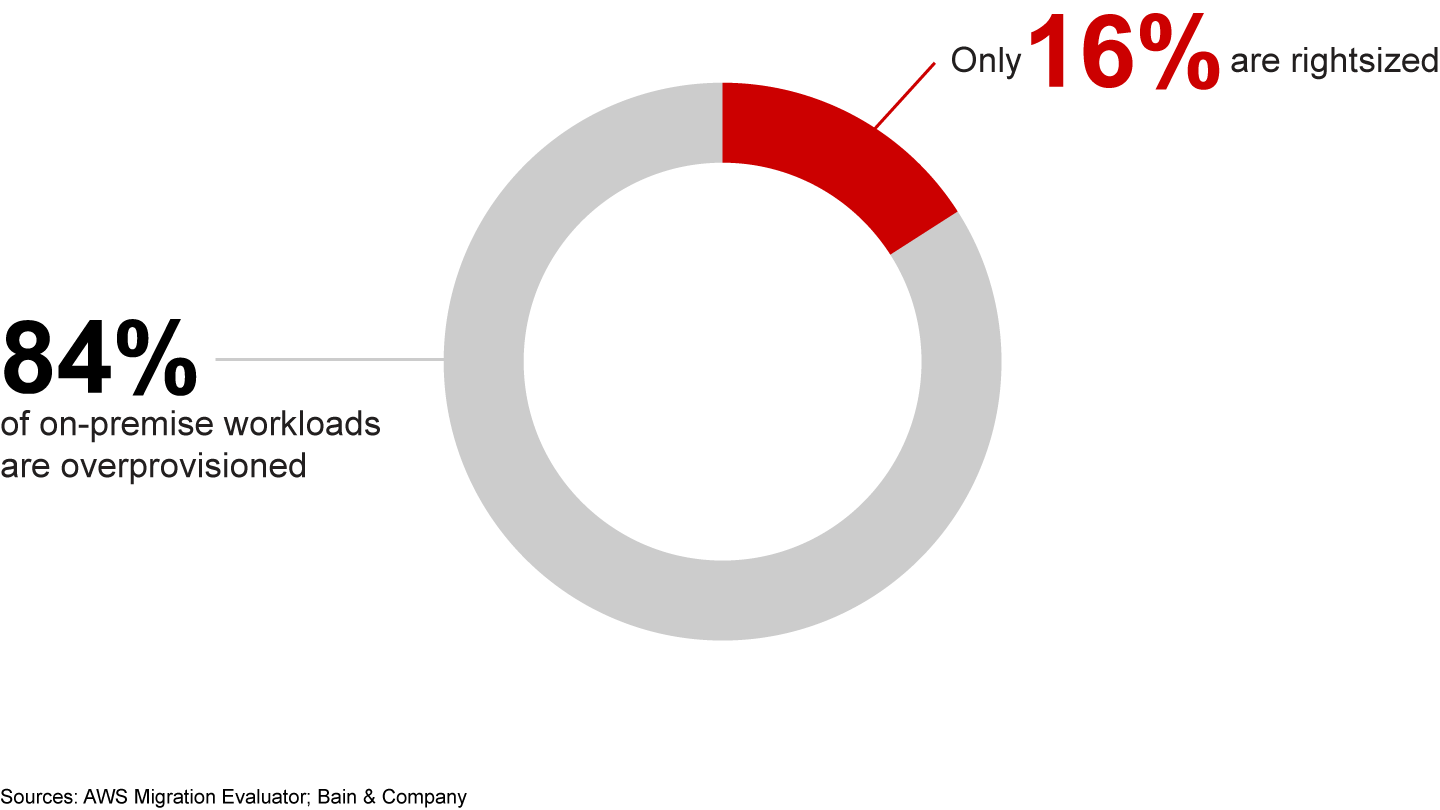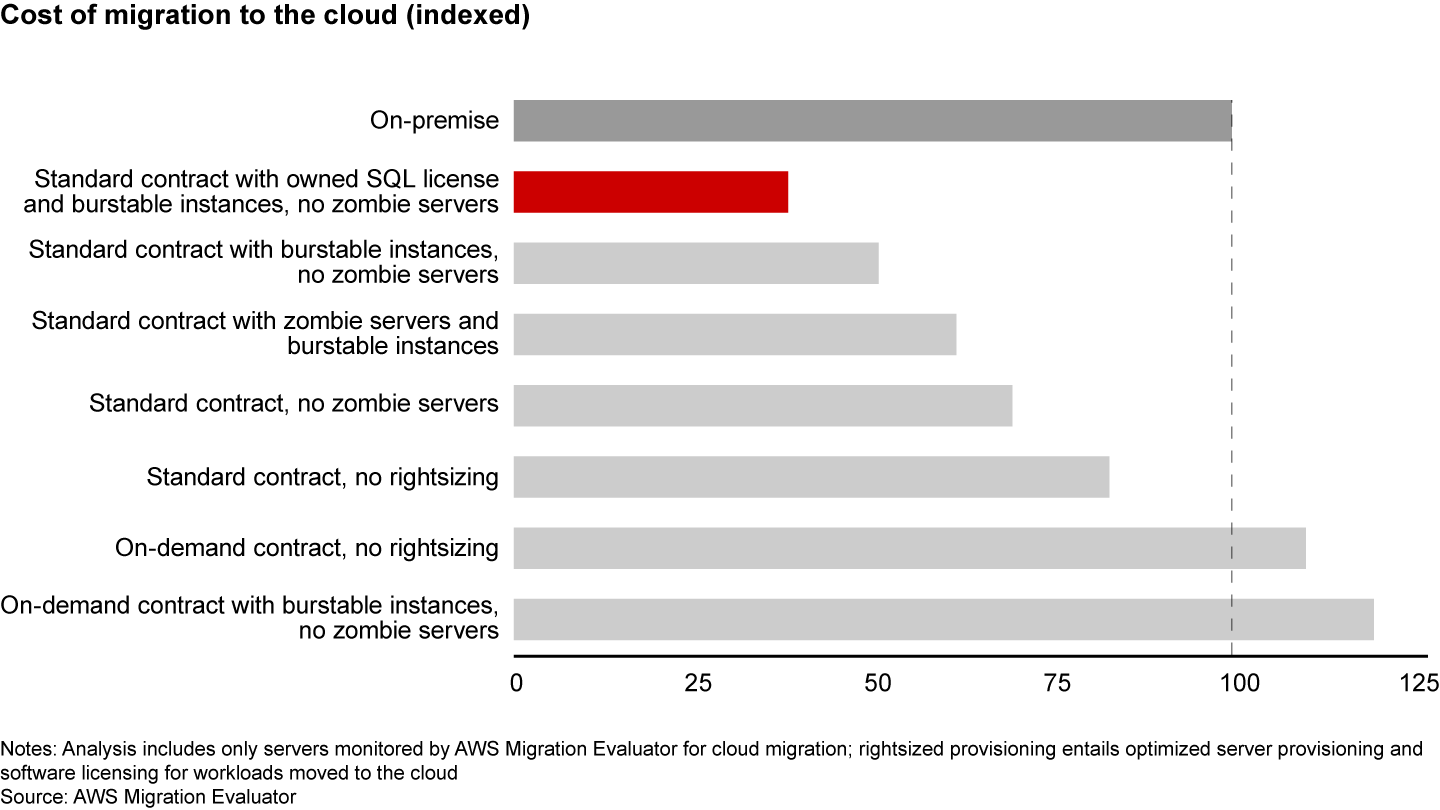Brief
 }
}
In evidenza
- Poorly planned direct-match migration to the public cloud can cost 10% to 15% more than keeping workloads on-premise, leaving many companies disappointed and frustrated.
- Eighty-four percent of workloads on-premise are overprovisioned, meaning that when companies migrate a workload to the cloud, they’re sending excess capacity along with it.
- Companies that “rightsize” their workloads to eliminate overprovisioning can cut costs by as much as 30% to 60%.
- Rightsizing creates opportunities for vendors as well—to help their customers scale, automate, and operate using public, private, and hybrid cloud models.
Written in collaboration with
Written in collaboration with

Why are companies often disappointed when they migrate their workloads to the public cloud? Many times, the promised efficiencies and savings just don’t materialize. In fact, when companies don’t do the necessary preparatory work, so-called direct-match migration to the public cloud—the like-for-like transfer of existing data, services, and applications—can be 10% to 15% more expensive that keeping the work in a legacy, on-premise environment, according to an analysis of more than 60,000 workloads by Bain & Company and Amazon Web Services (AWS). In other words, for all the vaunted promise of the cloud, it actually can be cheaper to keep things unchanged.
When we asked more than 350 IT decision makers what aspects of their cloud deployment had been the most disappointing, their top complaint was that the cost of ownership had not declined.
What’s gone wrong? Drawing on AWS Migration Evaluator, the migration assessment service for workload optimization, we have found that 84% of on-premise workloads are overprovisioned (see Figure 1). That means that when companies migrate a workload to the cloud, they're sending excess computing and storage capacity right along with it. Instead of becoming more efficient, they're merely transferring their existing inefficiencies to a new location. This practice is known among IT experts as “lift and shift.”


But there’s another way to do it. Companies that have mastered the art of migration to the public cloud take a disciplined approach to “rightsizing” their workloads. They view migration as an opportunity to thoroughly assess computing and storage practices throughout the company. They often find a great deal of fragmentation and duplication, with workloads scattered across machines and data centers. Records can be incomplete and outdated. Some companies discover “zombie servers,” computers that are no longer needed, but have never been purged or deactivated.
Our experience shows that companies that rightsize their workloads can cut costs by as much as 30% to 60% when they migrate them to the public cloud. Companies that achieve the highest savings have existing Microsoft SQL relational database-management-system licenses that can be migrated to the cloud. However, even companies without transferable licenses can generate considerable savings by rightsizing their workloads. That means eliminating zombie servers, winding down unnecessary activities, and accurately provisioning all the migrated work. Many companies find that they can more tightly provision their workloads if they establish a reserve of excess capacity that can be drawn on when needed for surges in activity—or so-called burstable instances (see Figure 2).


Companies that rightsize the right way carefully assess usage patterns. They study the intensity and duration of average peak computing demand, so they can make informed decisions about downsizing server capacity and accommodating some of that excess demand with burstable instances. They take a similar look at storage patterns, evaluating average and peak memory usage and proximity to the server so they can more effectively downsize. They also aim to rationalize the number of core processors they need, so they can optimize spending on software licensing fees that are tied to processor counts.
Smart companies also recognize that migration doesn’t treat all workloads equally. Companies are likely to save more when they migrate nonproduction workloads to the public cloud than when they migrate production workloads. That’s because the computing usage in nonproduction workloads tends to be more volatile and thus more likely to benefit from the flexibility the public cloud provides. Also, for testing and development activities, migration can help companies reduce software licensing fees that are tied to core processor counts. In addition, companies usually can achieve greater savings migrating nonvirtualized workloads rather than virtualized workloads. That’s because virtualization offers many of the same benefits the public cloud provides in terms of efficiency and flexibility.
The economics of cloud migration have notable implications for technology vendors. Customers are increasingly able to implement a cloud-transition roadmap that identifies and eliminates unused capacity in their on-premise environment. This can create a headwind for technology vendors, since rightsizing reduces demand for their systems and software. On the other hand, this presents an opportunity for vendors, which are well-positioned to help their customers face the enormous challenge of managing in a hybrid environment, with a mix of cloud and on-premise technologies.
There are signs that vendors recognize the potential of the cloud-migration opportunity, as demonstrated by IBM’s acquisition of Red Hat, a leading provider of cloud software. Companies are still in the early stages of cloud migration, and the complexity that they must manage is only increasing.
One company that has benefited from a rightsized migration to the public cloud is Morningstar, the financial research firm. The company faced a decision regarding contracts with multiple worldwide data centers that were set to expire. Should it renew data-center arrangements or should it migrate some or all workloads to the public cloud? Morningstar worked with AWS Migration Evaluator to evaluate the potential costs and benefits of migration, bearing in mind that Morningstar had a substantial on-premise infrastructure. By rightsizing its workloads, Morningstar found that the majority of its instances would cost 30% less if operated in the cloud.
Rightsizing can make a dramatic difference. AWS Migration Evaluator’s experience shows that direct-match migration of 105,000 server instances and 20 terabytes of storage on-premise would increase costs by 22%, while rightsizing those workloads would reduce costs by 36%.
These results demonstrate that migration to the public cloud doesn't have to be disappointing. The public cloud offers great benefits to companies trying to keep pace with digital innovation. It’s easy to use and can be scaled on demand; it’s reliable and features continuous uptime; and companies don’t have to spend a penny on maintenance. When companies rightsize their workloads, they can reap all these benefits of the public cloud and actually save money in the process.

Written in collaboration with AWS Migration Evaluator
AWS Migration Evaluator (formerly TSO Logic) provided data, insights, and analysis used in this report. AWS Migration Evaluator’s services optimizes cloud planning to support a data-based business case for transformation.